In 1919, General Motors bought a small company that was producing an alternative to the icebox. It was a compact refrigeration unit with a storage compartment above a compressor. GM called it the Frigidaire and used mass-production techniques to drive down the price from $775 per unit when it first bought the company to $180 in 1930. (Even that cost — the equivalent to $2,600 today — was prohibitive for most families, and GM offered financing for its refrigerators, just as it did for the family sedan.)
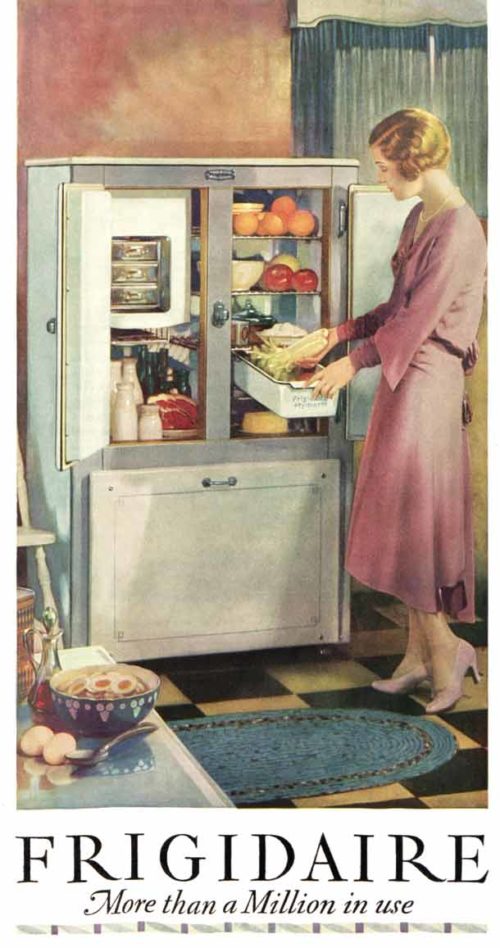
In this color ad from 1930, the company showed its refrigerator as a part of the stylish kitchen in a modern home. The kitchen is decorated with then-fashionable checkered linoleum and dark green curtains on the windows, plus a homemaker who finds cooking so easy she makes dinner wearing pearls and high heels. At the time of this ad’s appearance, over 90 percent of Americans still lived in the icebox era. But the allure of consistent refrigeration ultimately won Americans over. By 1940, nearly every home had a refrigerator.
This gallery of vintage Frigidaire hints not only at Frigidaire’s growth and the rapid acceptance of home refrigeration, but technological advances in magazine advertising as well.
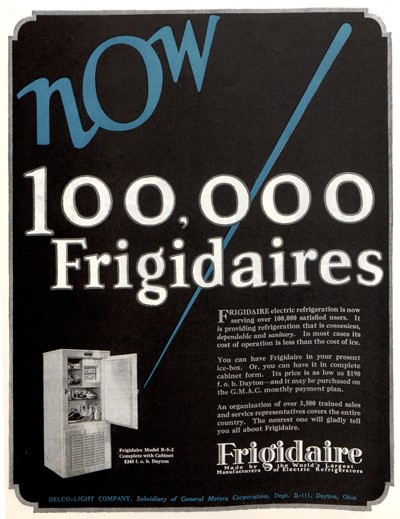
Selling 100,000 refrigerators seems like a small milestone by today’s standards, but when this ad appeared in November 1925, the vast majority of Post readers were still using ice boxes. Ads like this hoped to convince readers not only of a Frigidaire’s usefulness, but of its growing popularity.
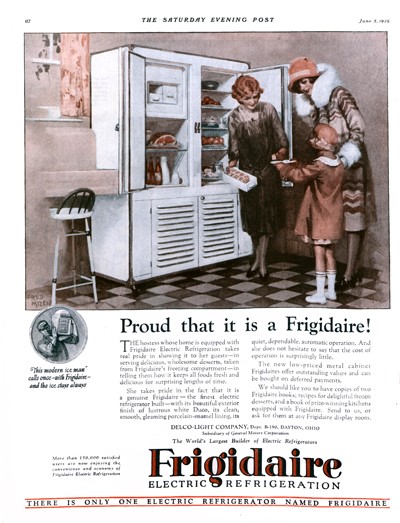
Less than seven months later, the number of “satisfied users” had increased by at least 50 percent. This ad’s appeal to pride is an early example of creating an emotional link between a product and a consumer — what we think of as branding today — in order to build brand loyalty.
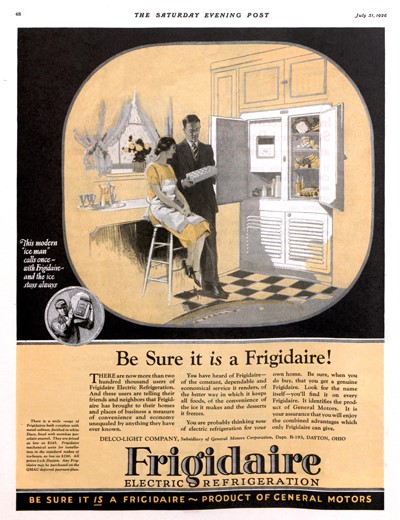
The focus in this ad is on buying a Frigidaire, not using it, so it is directed at the family breadwinner. That is perhaps why this ad, unlike most others, depicts a man — presumably the woman’s husband — in the kitchen. This sort of casual sexism, though unremarkable when this ad appeared in July 1926, would get lambasted today.
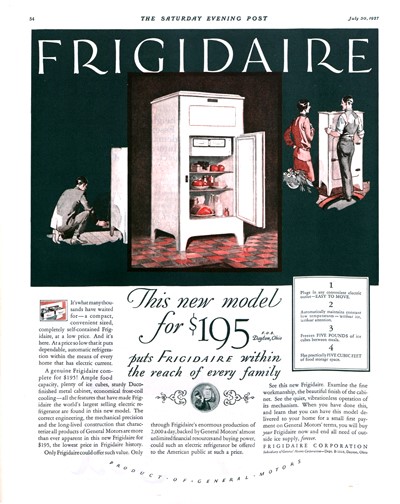
This ad from July 1927 touts the luxuries of Frigidaire’s new model, including “ample food capacity” of “practically FIVE CUBIC FEET of food storage space.” By today’s standards, this would be a large mini-fridge; even the smallest upright refrigerators of today have nearly 10 cubic feet of storage space.
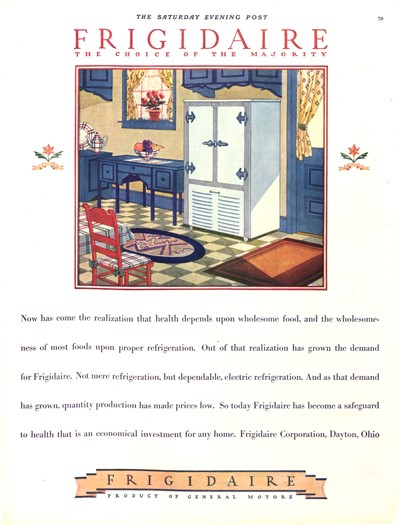
By April of 1928, when this ad appeared, Frigidaire had shifted from touting the convenience and popularity of its refrigerators to marketing them as a “vital safeguard to health.” The preference for checkered linoleum in the kitchen is still going strong here, too.
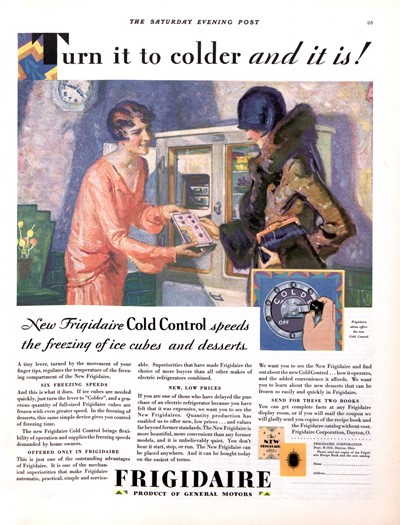
In February of 1929, Frigidaire models offered six “freezing speeds” that let owners create ice cubes and chilled desserts even faster. Notice how the advertisers subtly reinforce how cold the freezer can get by having the guest wearing a hat and fur-lined coat.
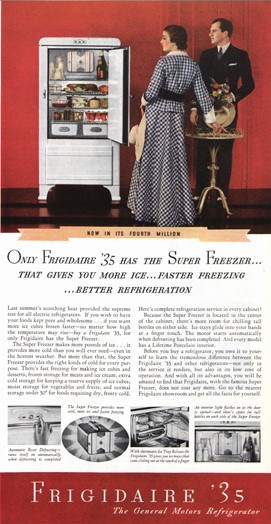
By mid-1935, Frigidaire was touting cutting edge refrigerator technology, including that “Super Freezer,” an all-porcelain interior, and — a fairly new innovation — a light bulb the turns on when you open the door.
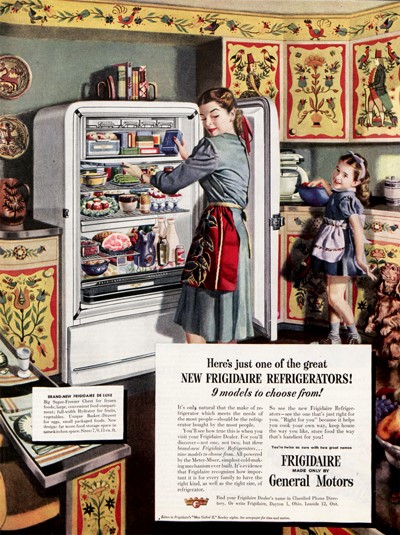
A lot changed after World War II — for the United States and for Frigidaire, as you can see in this ad from September 1948. Gone are the checkered linoleum floor and bare walls, replaced by a solid floor and hand-painted cabinet doors and wall trim. Frigidaire offered nine different models, and these were the first to have completely separated refrigerator and freezer sections.
An abridged version of this article is featured in the September/October 2017 issue of The Saturday Evening Post. Subscribe to the magazine for more art, inspiring stories, fiction, humor, and features from our archives.
Become a Saturday Evening Post member and enjoy unlimited access. Subscribe now
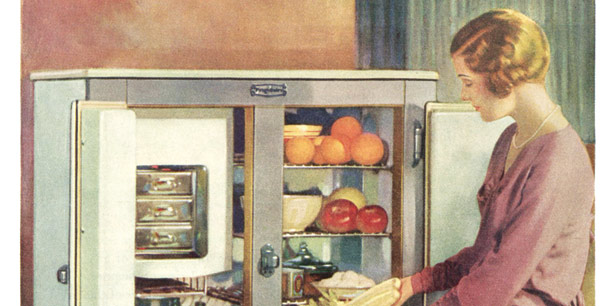
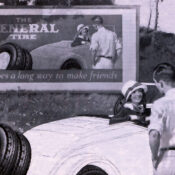


Comments
Thank you for inventing this! We are using this in our school project!
I remeber the Ice delivery man coming to bring a new Chunk of ice for our ice box. My family was one of the first families in the neighborhood to buy a refrigerator. We were considered to be wealthy because we had a refrigerator. However, there were questions- What if it breaks- where will you put the food? In the beginning my Mother went to the store every afternoon and bought just enough regrigerator food for the next day. Parents wanted to be sure food was not lost if the refrigerator broke down.
In 1954 my Mother, as a new bride, walked into her newly built home equipped with the latest Frigidaire appliances. Oddly enough our family members, now long married with homes of their own, still refer to their own refrigerators, no matter the brand, as “the fridge” or “put it in the ice box”. Mom’s Frigidaire lasted 20+ years, until she decided a new kitchen was in order. And yes, she chose another Frigidaire.
I have a wooden Frigidaire ice box, it was in a house that was to be bulldozed down saving nothing in it. At the time my husband worked for the local company that sold Frigidaire appliances, he was a serviceman, he along with two of our sons, couldn’t stand the thought that this bit of history was about to be crushed and burned.